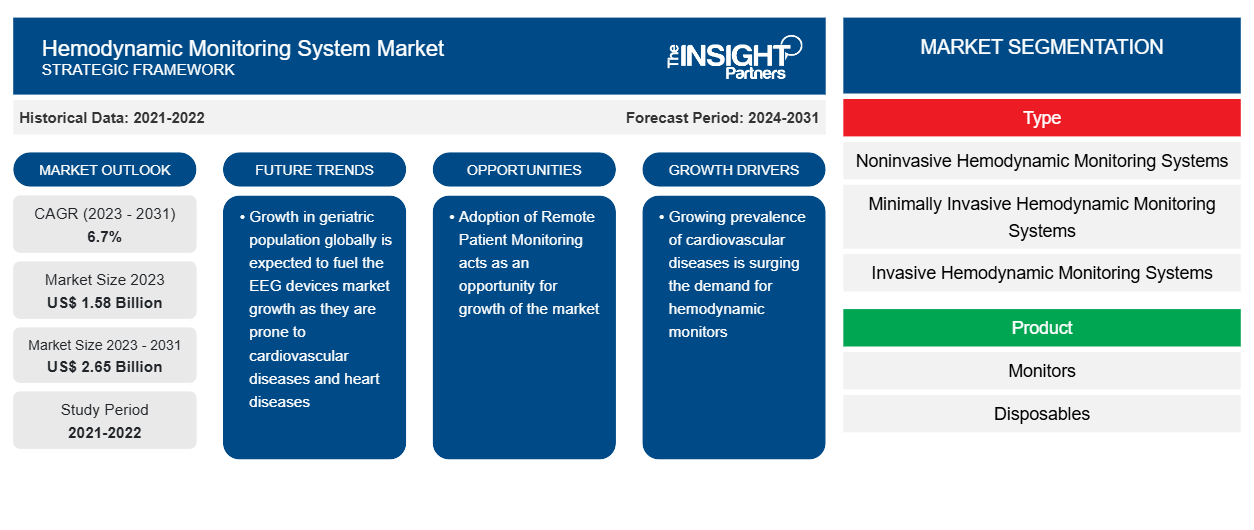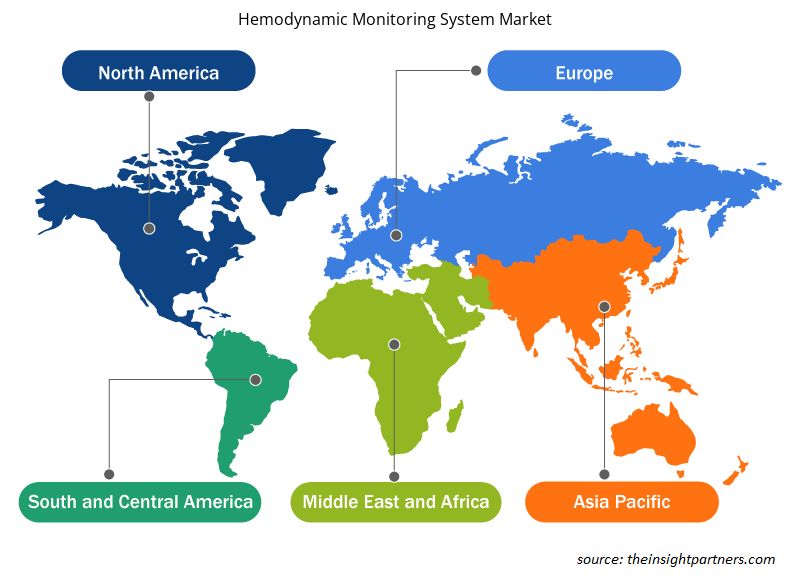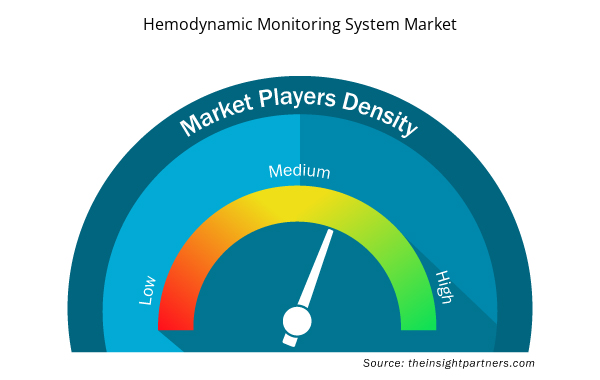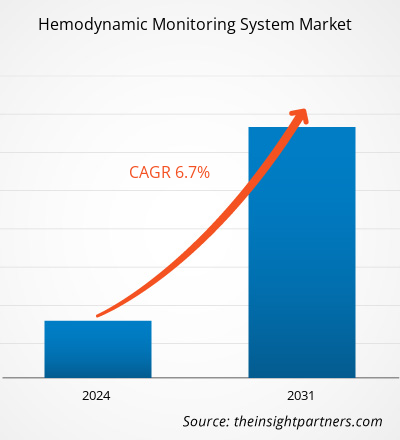The hemodynamic monitoring system market size is projected to reach US$ 2.65 billion by 2031 from US$ 1.58 billion in 2023. The market is expected to register a CAGR of 6.7% during 2023–2031. Use of artificial intelligence and machine learning is likely to remain key trend in the market.
Hemodynamic Monitoring System Market Analysis
Hemodynamic monitoring system is used to monitor the blood circulation of patient and evaluate the heart health. Thus, increasing prevalence of heart related diseases due to growing geriatric population and detection of pediatric heart conditions is fueling the demand for hemodynamic monitoring system. In addition, increasing investment for research and development of hemodynamic monitoring system, awareness initiatives for heart health, and growing focus on patient safety and care quality is driving the growth of the hemodynamic monitoring system market. Moreover, rising demand for critical care monitoring in intensive care units, emergency departments, and operating rooms is also fueling the growth of the market. Expansion of home healthcare services and remote patient monitoring program acts as an opportunity for growth of the market in the forecast period.
Hemodynamic Monitoring System Market Overview
Geographically, Asia Pacific is expected to register highest CAGR in the forecast period 2023-2031. Increasing focus on market players on introduction of technologically advanced products in Asia Pacific, growing adoption of home healthcare services, growing demand for non-invasive diagnostic techniques, and increasing R&D activities is fueling the growth of the Asia Pacific hemodynamic monitoring system market. Moreover, growing geriatric population, rising healthcare expenditure, increasing prevalence of cardiovascular diseases (CVDS), and improving government support for creating awareness about heart health is fueling the growth of the market in Asia Pacific.
Customize This Report To Suit Your Requirement
You will get customization on any report - free of charge - including parts of this report, or country-level analysis, Excel Data pack, as well as avail great offers and discounts for start-ups & universities
Hemodynamic Monitoring System Market: Strategic Insights

- Get Top Key Market Trends of this report.This FREE sample will include data analysis, ranging from market trends to estimates and forecasts.
Customize This Report To Suit Your Requirement
You will get customization on any report - free of charge - including parts of this report, or country-level analysis, Excel Data pack, as well as avail great offers and discounts for start-ups & universities
Hemodynamic Monitoring System Market: Strategic Insights

- Get Top Key Market Trends of this report.This FREE sample will include data analysis, ranging from market trends to estimates and forecasts.
Hemodynamic Monitoring System Market Drivers and Opportunities
Increasing Prevalence of Cardiovascular Diseases to Favor Market
Cardiovascular diseases (CVDs) cause millions of deaths every year worldwide. According to the 2022 heart disease & Stroke Statistical Update Fact Sheet, Global Burden of Disease, an estimated 119.1 million people died of CVDs in 2020. It also stated that the global prevalence of stroke and ischemic stroke in 2020 was 89.1 million and 68.2 million, respectively. The major causes of CVDs are hypertension, obesity, and diabetes. As per the World Health Organization (WHO), ~17.9 million lives are lost due to CVD every year, i.e., ~32% of all deaths reported globally. The awareness regarding CPR is high in western countries. According to the Centers for Disease Control and Prevention (CDC), ~350,000 cases of out-of-hospital cardiac arrest (OHCA) occur in the US every year. Hemodynamic monitors allow measurement of cardiac functions and blood circulation in cardiac patients. The monitoring allows physicians to measure blood pressure from inside the veins, arteries, and heart. Thus, growing prevalence of CVDs is surging the demand for hemodynamic monitors.
Adoption of Remote Patient Monitoring act as an Opportunity for Market Growth
By monitoring a patient’s vitals remotely, healthcare professionals can avoid admissions to healthcare facilities. If the cases can be handled virtually, beds are reserved only for patients requiring critical care, which allows hospital administrations to manage their resources more effectively. A shift from long-term facilities, inpatient rehabilitation, and skilled nursing facilities to home care settings results in greater chances of better, consistent, and timely interaction between patient and doctor owing to the growing prominence of cloud and mobility-driven medical devices. Increasing adoption of remote patient monitoring by integrating devices with electronic medical records (EMR) for real-time analysis of the results creating opportunity for growth of the hemodynamic monitors.
Hemodynamic Monitoring System Market Report Segmentation Analysis
Key segments that contributed to the derivation of the hemodynamic monitoring system market analysis are product, type, and end user.
- Based on type, the hemodynamic monitoring system market is divided into noninvasive hemodynamic monitoring system, minimally invasive hemodynamic monitoring systems, and invasive hemodynamic monitoring systems. The noninvasive hemodynamic monitoring system segment is further divided into non-Invasive cardiac system and others. The invasive hemodynamic monitoring system segment held the largest market share in 2023.
- In terms of product, the market is bifurcated into monitors and disposables. The disposables segment held a significant share of the market in 2023.
- Based on end user, the hemodynamic monitoring system market is divided into hospitals, cath labs, home care, and ambulatory surgical centers. The hospitals segment held the largest market share in 2023.
Hemodynamic Monitoring System Market Share Analysis by Geography
The geographic scope of the hemodynamic monitoring system market report is mainly divided into five regions: North America, Asia Pacific, Europe, Middle East & Africa, and South & Central America.
North America has dominated the market. The projected growth of the hemodynamic monitoring system market in North America is attributed to the factors such as increasing health expenditure, rising cardiovascular disease prevalence, increasing awareness about heart health, and growing geriatric population. The prevalence of CVDs in the US is much higher, as more than 50% population is suffering from different types of CVDs. According to the Centers for Disease Control and Prevention (CDC), every year, more than 0.6 million people die due to CVDs; this nearly accounts for one in every four deaths. The primary cause of CVDs among people is hypertension, obesity, and diabetes. Furthermore, various organizations are focusing on introducing programs for the care and treatment of CVDs and creating awareness about these treatments in Mexico. For instance, in June 2022, the American Heart Association launched a 2-year program funded by Novartis Mexico to improve the consistency of care for CVDs.
Hemodynamic Monitoring System Market Regional Insights
The regional trends and factors influencing the Hemodynamic Monitoring System Market throughout the forecast period have been thoroughly explained by the analysts at Insight Partners. This section also discusses Hemodynamic Monitoring System Market segments and geography across North America, Europe, Asia Pacific, Middle East and Africa, and South and Central America.

- Get the Regional Specific Data for Hemodynamic Monitoring System Market
Hemodynamic Monitoring System Market Report Scope
| Report Attribute | Details |
|---|---|
| Market size in 2023 | US$ 1.58 Billion |
| Market Size by 2031 | US$ 2.65 Billion |
| Global CAGR (2023 - 2031) | 6.7% |
| Historical Data | 2021-2022 |
| Forecast period | 2024-2031 |
| Segments Covered |
By Type
|
| Regions and Countries Covered | North America
|
| Market leaders and key company profiles |
Hemodynamic Monitoring System Market Players Density: Understanding Its Impact on Business Dynamics
The Hemodynamic Monitoring System Market market is growing rapidly, driven by increasing end-user demand due to factors such as evolving consumer preferences, technological advancements, and greater awareness of the product's benefits. As demand rises, businesses are expanding their offerings, innovating to meet consumer needs, and capitalizing on emerging trends, which further fuels market growth.
Market players density refers to the distribution of firms or companies operating within a particular market or industry. It indicates how many competitors (market players) are present in a given market space relative to its size or total market value.
Major Companies operating in the Hemodynamic Monitoring System Market are:
- Koninklijke Philips NV
- Osypka Medical GmbH
- General Electric Co
- Edwards Lifesciences Corporation
- Schwarzer Cardiotek
- Getinge Group
Disclaimer: The companies listed above are not ranked in any particular order.

- Get the Hemodynamic Monitoring System Market top key players overview
Hemodynamic Monitoring System Market News and Recent Developments
The Hemodynamic Monitoring System market is evaluated by gathering qualitative and quantitative data post primary and secondary research, which includes important corporate publications, association data, and databases. A few of the developments in the hemodynamic monitoring system market are listed below:
- Mindray Medical with Edwards Lifesciences integrated Edwards FloTrac sensor for hemodynamic monitoring into Mindray's flagship BeneVision N series patient monitors in the European market, following their launch in China in 2022. (Source: Mindray, Company Website, June 2023)
- Royal Philips integrated its Interventional Hemodynamic System and market-leading portable Patient Monitor IntelliVue X3, providing advanced hemodynamic (blood flow) measurements at the tableside in the cath lab and continuous monitoring of key vital signs throughout the patient journey. (Source: Philips, Company Website, May 2021)
Hemodynamic Monitoring System Market Report Coverage and Deliverables
The “hemodynamic monitoring system Market Size and Forecast (2021–2031)” report provides a detailed analysis of the market covering below areas:
- hemodynamic monitoring system market size and forecast at global, regional, and country levels for all the key market segments covered under the scope
- hemodynamic monitoring system market trends as well as market dynamics such as drivers, restraints, and key opportunities
- Detailed PEST/Porter’s Five Forces and SWOT analysis
- hemodynamic monitoring system market analysis covering key market trends, global and regional framework, major players, regulations, and recent market developments
- Industry landscape and competition analysis covering market concentration, heat map analysis, prominent players, and recent developments for the hemodynamic monitoring system market
- Detailed company profiles
- Historical Analysis (2 Years), Base Year, Forecast (7 Years) with CAGR
- PEST and SWOT Analysis
- Market Size Value / Volume - Global, Regional, Country
- Industry and Competitive Landscape
- Excel Dataset



Report Coverage
Revenue forecast, Company Analysis, Industry landscape, Growth factors, and Trends

Segment Covered
Type, Product, and End User

Regional Scope
North America, Europe, Asia Pacific, Middle East & Africa, South & Central America

Country Scope
Argentina, Australia, Brazil, Canada, China, France, Germany, India, Italy, Japan, Mexico, Saudi Arabia, South Africa, South Korea, Spain, United Arab Emirates, United Kingdom, United States
Frequently Asked Questions
North America dominated the hemodynamic monitoring system market in 2023.
Growing incidences of cardiovascular diseases, rising demand for critical care monitoring, and significantly rising elderly population are among the most influential factors responsible for the market growth.
Use of artificial intelligence and machine learning are likely to remain key trends in the hemodynamic monitoring system market.
Koninklijke Philips NV, Osypka Medical GmbH, General Electric Co, Edwards Lifesciences Corporation, Schwarzer Cardiotek, Getinge Group, Deltex Medical, ICU MEDICAL INC., Masimo, and Baxter International Inc. are among the key players operating in the market.
The hemodynamic monitoring system market is estimated to reach US$ 2.65 billion in 2031.
The hemodynamic monitoring system market is anticipated to record a CAGR of 6.7% during 2023–2031.

 Get Free Sample For
Get Free Sample For